

Wrapping up: asking students to reflect and evaluate. Guest Author: Alexis Carrozza.

Regeneration may cause isolation for older people, study finds. A study by an academic from The University of Manchester has found that urban regeneration in poor neighbourhoods can actually backfire, and lead to older people feeling isolated.
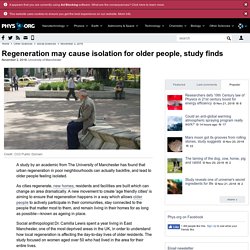
As cities regenerate, new homes, residents and facilities are built which can change an area dramatically. A new movement to create 'age friendly cities' is aiming to ensure that regeneration happens in a way which allows older people to actively participate in their communities, stay connected to the people that matter most to them, and remain living in their homes for as long as possible—known as ageing in place. Social anthropologist Dr. Camilla Lewis spent a year living in East Manchester, one of the most deprived areas in the UK, in order to understand how local regeneration is affecting the day-to-day lives of older residents. The study focused on women aged over 50 who had lived in the area for their entire lives. Are things better or worse than 50 years ago? I saw reference the other day to a new(ish) multi-country survey conducted by the Pew Research Center last year, asking people in 38 countries whether life in their country was better, worse, or not much different for people like them than it had been 50 years previously.
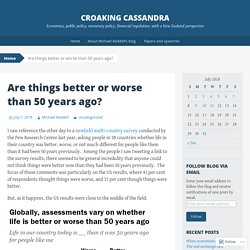
Among the people I saw tweeting a link to the survey results, there seemed to be general incredulity that anyone could not think things were better now than they had been 50 years previously. The focus of those comments was particularly on the US results, where 41 per cent of respondents thought things were worse, and 37 per cent though things were better. Astrological Cycles in History (Uranus, Neptune and Pluto Conjunctions) - by Palden Jenkins. History and the cycles of Uranus, Neptune and PlutoWhen I was young I asked my history teacher whether there were such things as cycles in history.
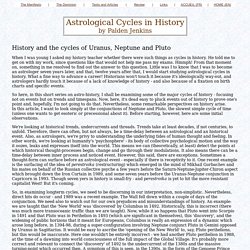
He told me to get on with my work, since questions like that would not help me pass my exams. 50 Years Ago, This Was a Wasteland. He Changed Everything. Were people really happier in the past? Millions of pieces of text suggest not. Ever wondered whether people were happier in the past?
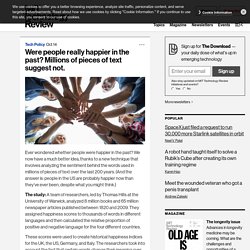
We now have a much better idea, thanks to a new technique that involves analyzing the sentiment behind the words used in millions of pieces of text over the last 200 years. (And the answer is: people in the US are probably happier now than they’ve ever been, despite what you might think.) The study: A team of researchers, led by Thomas Hills at the University of Warwick, analyzed 8 million books and 65 million newspaper articles published between 1820 and 2009. They assigned happiness scores to thousands of words in different languages and then calculated the relative proportion of positive and negative language for the four different countries. Life after cool – Jessica Wildfire.
Stunning Editorial From the New Yorker. Here’s a stunning editorial from The New Yorker Magazine, by Jonathan Schell: …..a question has been haunting our national life.

It is whether the Republic will live or die. Model Metropolis. By Kevin T.
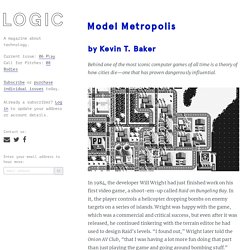
Baker Behind one of the most iconic computer games of all time is a theory of how cities die—one that has proven dangerously influential. In 1984, the developer Will Wright had just finished work on his first video game, a shoot-em-up called Raid on Bungeling Bay. 85 Years, 85 Ideas. A People's History of the United States. The Note: This great book should really be read by everyone.
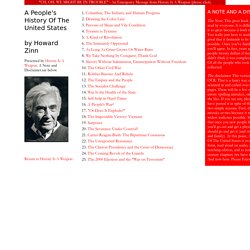
It is difficult to describe why it so great because it both teaches and inspires. You really just have to read it. We think it is so good that it demands to be as accessible as possible. Once you've finished it, we're sure you'll agree. AP World History Notes Visual. Powered by WorldMap AP World History Notes Visual Sign in | Create Map | View Map | Help Rectify Images.

40,000-year-old bracelet made by extinct human species found. The bracelet was discovered in a site called the Denisova Cave in Siberia, close to Russia's border with China and Mongolia.
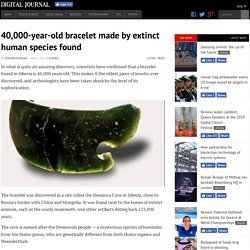
It was found next to the bones of extinct animals, such as the wooly mammoth, and other artifacts dating back 125,000 years. The cave is named after the Denisovan people — a mysterious species of hominins from the Homo genus, who are genetically different from both Homo sapiens and Neanderthals. We know that the Denisovans migrated out of Africa sometime after the first wave of Homo erectus, and well before us, Homo sapiens. READ MORE:Sea salt is contaminated with micro plastics, study finds The Denisovans were unique in many ways, having branched away from other humanoid ancestors some 1 million years ago. Indeed, the recent discovery of a female Denisovan finger bone and various teeth shows that they had no morphological similarities to either Neanderthals or modern humans.
This evolution graphic will make you feel tiny - Business Insider. A Newly Drawn Tree of Life Reminds Us to Question What We Know About the History of Earth. New research supports hypothesis that asteroid contributed to mass extinction. A team of scientists from South Africa has discovered evidence partially supporting a hypothesis that Earth was struck by a meteorite or asteroid 12 800 years ago, leading to global consequences including climate change, and contributing to the extinction of many species of large animals at the time of an episode called the Younger Dryas. The big five mass extinctions.
Planetary. Time Well Spent. Eternity. Futuresque. Lists to peruse.